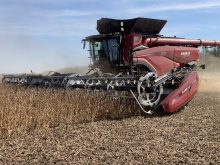Study to see if later fungicide application and grinding straw residue can help reduce risk of the disease
LACOMBE, Alta. — Researchers across Canada are hoping to better understand what management practices work best to reduce fusarium head blight in cereal crops.
Trials on the Prairies and in Eastern Canada will potentially determine whether wider rows, longer rotations, later fungicide application and grinding straw residue can help reduce the risks of fusarium.
The disease has been challenging to deal with, particularly for farmers in northeastern Saskatchewan, even though fungicides and resistant varieties are being used, said Kelly Turkington, a research scientist with Agriculture Canada.
Read Also

Bunge’s crop mix is changing
Bunge has predominantly been a soybean processing firm, but that’s about to change after the merger with Viterra with softseed processing and grain merchandising gaining ground.
“Despite doing everything the experts are telling them, producers are still getting hammered in terms of grade reduction,” he said, following a field tour in July at the Field Crop Development Centre in Lacombe.
“The tools we have right now either aren’t great or we’re not using them the way we should, so we need to improve that.”
Turkington said researchers will see if spraying fungicides later than normal will help ward off the disease. Currently, the recommended time to spray is when there is 75 percent head emergence, but he wonders if that’s too early.
“When you spray at 75 percent head emergence, you still have 25 percent that hasn’t emerged. That 25 percent isn’t being targeted,” he explained. “You need fungicide directly on the head tissue for it to be effective.”
As for managing straw residue, Turkington said researchers will remove it completely or grind it down as finely as possible. While that might not seem practical for farmers, he said having finer residue allows bacteria or fungi to better decompose it, therefore helping fusarium disappear.
As well, researchers will see if wider rows can help reduce disease impacts. The theory is wider rows allow the crops to dry better, making it more difficult for fusarium to spread.
However, Turkington said past research in barley found 12-inch rows had more disease than nine-inch rows.
“Those 12-inch rows weren’t wide enough to have a significant impact. It was still enough to facilitate spores,” he said.
The fungicide application, row spacing and residue management practices will be used in conjunction with one another.
As well, adding a non-host crop in the rotation will be looked at. Doing so would give bacteria more time to break down straw residue from the previous cereal crop.
“Our typical rotations are cereal-canola-cereal, and that one-year interval of those crops isn’t long enough,” he said.
There has been talk about going back to conventional tillage to reduce fusarium, but Turkington said he cautions against that.
He pointed to cases in Manitoba during the mid-1980s to early 1990s, when many farmers tilled to get rid of fusarium. The problem, though, is those efforts didn’t work.
“They didn’t mitigate that risk by doing that,” he said.
As well, findings in Europe are showing that mouldboard plowing can help, but it doesn’t eliminate the problem, he added.
Turkington expects results from some of the trials to be available within a year. Results from the trial in Lacombe are expected to be available in 2022.
















